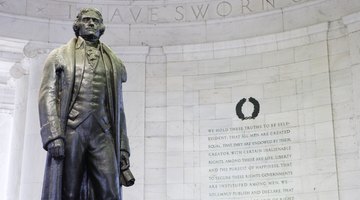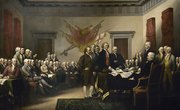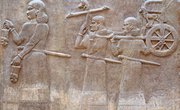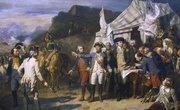Jeffersonian democracy is a term used for the political ideals of Thomas Jefferson (1743-1826), the third U.S. president, and his followers from the 1790s until the presidency of Andrew Jackson in the 1830s. Jefferson advocated a political system that favored public education, free voting, free press, limited government and agrarian democracy and shied away from aristocratic rule. Although these were his personal beliefs, his presidency (1801-1809) often veered from these values.
Republicanism
Jefferson had faith that reason ruled the majority of citizens. Jefferson’s republican beliefs favored a largely rural populace with limited governmental interference. He, like many of the founding fathers, wanted a republican system in which power is shared by the states and federal government. Jefferson envisioned a federal government of limited powers, which put him at odds with city dwellers like John Adams, the second president, and Alexander Hamilton, who wanted a powerful central government.
Political Parties
The rivalry between Jefferson and Hamilton led to the formation of two political parties in the 1790s. Jefferson’s Republican Party -- often referred to as the Democrat-Republican Party to distinguish it from the modern Republican Party founded in the 1850s -- favored his ideals of limited government, economic freedom and agrarian democracy. A faction of this party formed into the Democratic Party under Andrew Jackson in the late 1820s. Hamilton’s Federalist Party favored a mercantilist economy and greater federal control. Although both parties advocated federalism, the Federalists favored a strong centralized government at the expense of the states. Anti-Federalists, on the other hand, wanted governmental power to lie at the state level. However, Jefferson’s battles with the Supreme Court for executive control, his military spending during the Barbary War and the Louisiana Purchase often put him more in line with the federalist camp. Thus, his presidency is not always seen as a model of limited government. In Jefferson’s era, the Democrat-Republican Party controlled the presidency.
Virginian Aristocracy
Although the first president, George Washington, was also a Virginian, Jefferson was the first of the so-called "Virginia Dynasty." The presidencies of fellow Virginians James Madison and James Monroe followed, and each served two terms. These three formed the core of the Jeffersonian democracy. Their concept of a government controlled by average, particularly rural, citizens put it at odds with the aristocratic British model of a strong, central government controlled by a wealthy elite. The American Revolution also added to an anti-British and anti-aristocratic feeling among many Americans, especially the Democrat-Republicans. The Federalists, particularly Hamilton, felt that the United States was bred from the British system, and, in many respects, they sought to emulate it. In contrast, Jefferson felt that the citizenry formed a "natural aristocracy" whose values came from work and talent, not birthright or wealth.
Agrarian Democracy
Jefferson envisioned a country ruled by yeoman farmers. Jefferson felt that urbanization, industrial factories and financial speculation would serve to rob the common man of his independence and economic freedom. To Jefferson, expansion of the United States into the American west would provide the space and land needed to support an agrarian democracy. Jefferson exerted strong executive influence to oversee the Louisiana Purchase for such a purpose. He felt it was important that the national economy be based in agriculture and the labor of the independent farmer.
Related Articles
References
- USHistory.org: Jeffersonian Ideology
- University of Virginia The American Studies Group: The Hamilton Years: The Formation of the Republican Party
- University of Chicago Press: Republican Government
- University of Virginia Miller Center: American President: Thomas Jefferson Foreign Affairs
- University of Virginia The American Studies Group: The Yoeman
Resources
Writer Bio
John Peterson published his first article in 1992. Having written extensively on North American archaeology and material culture, he has contributed to various archaeological journals and publications. Peterson has a Bachelor of Arts from Eastern New Mexico University and a Master of Arts from the University of Nebraska, both in anthropology, as well as a Bachelor of Arts in history from Columbia College.











